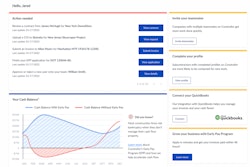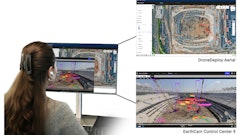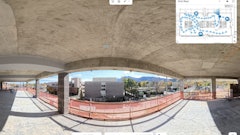
Trimble has been quiet about the future of the Viewpoint construction enterprise resource planning (ERP) products, Vista and Spectrum, or exactly how they fit into their announced Trimble Construction One suite. They recently broke the silence in a series of debriefing calls with ForConstructionPros, outlining development efforts that should be released to market later in 2022 and the following year.
Since Trimble acquired construction management software provider Viewpoint in 2018, they according to users and partners went a bit silent on the future of the product—which is not uncommon after a large acquisition. This has started to change as Trimble outlined their plans for a broad suite of products dubbed Trimble Construction One. A September 2021 Trimble announcement on the product said it was to be “connected construction software management software” that would allow them to:
- Plan: Connect data from the planning phases of a project—estimating, design and detailing, content and pricing services—to the project actuals, leading to more predictable construction outcomes.
- Do: More efficiently do actual project work—project management, field management, service management—and map that data back to the project, leading to optimal resource utilization and cost savings.
- Manage: Spend less time on project administration, bringing financial management, business operations management, job costing, payroll and procurement together with ongoing project completion rates to ensure greater overall efficiency and project profitability.
The announcement of the Viewpoint acquisition was also close on the heels and linked in company announcement to its acquisition that same year of e-Builder—a construction program management solution for project owners and administrators.
Trimble had earlier acquired mechanical, electrical and plumbing (MEP) construction estimating solutions Quickpen in 2009 and Accubid in 2010 that round out the pre-construction solution set of Trimble Construction One. Also under the Trimble Construction One umbrella are Tekla 3D for building information management (BIM), SketchUp 3D modeling software, Novapoint, BIM and 3D modeling tools, project management software Meridian Systems, and the Vico Systems 5D BIM solution.
Trimble also offers Trimble Pulse, a GPS-enabled asset management application aimed at construction contractors that also has a standard integration with Viewpoint.
What is the fate of ERP products Viewpoint Vista and Spectrum as Trimble works towards a product line as unified as the Trimble Construction One name implies? Will Trimble be investing further in its construction software portfolio? Will the different components that make up the offering benefit from greater interoperability? We’ll explore all of that here.
Trimble Construction One
In its external messaging, Trimble is definitely positioning Viewpoint Vista, Viewpoint Spectrum (formerly Dexter + Cheney) as part of Trimble and their broader Trimble Construction One suite.
“We are creating an industry platform,” Trimble Vice President and Category Manager Rachel Winkler said. “And that platform connects workflows that create value for the customer. So, a construction platform would be everything that a contractor needs or an owner needs to maintain their space or an architect or designer on the front end of the construction process might need. What we are doing is identifying what these different areas need, pulling these things together and starting to connect them. We need APIs (application programming interfaces). We need to be able to connect the platform.”
While spanning a comprehensive set of functionality for both owners and contractors, Trimble Construction One is comprised of solutions developed separately from each other. Trimble is faced with the task of making them work and play well with each other as part of a whole. This includes products like Viewpoint Vista and Spectrum that were designed for on-premise use and now are hosted as single tenancies in the cloud and more modern products built in the cloud as multi-tenant software-as-a-service (SaaS) software products sold by subscription.
“Trimble Viewpoint is hosted in the cloud—but some products will be net new in the cloud,” Winkler said, calling out that existing Viewpoint users running on premise can transparently move their instance into the Microsoft Azure Cloud and deliver net new benefits on top of that.
“We are entering new areas beyond Viewpoint though,” Winkler said. “Our analytics platform is only for customers that have taken their ERP to the cloud. Our product allows them to run reports on Microsoft Power BI … We are evolving in the way we provide quarterly industry insights into hiring trends, margins, and can get very granular with the type of projects we can report on. You can compare yourself to the market or make a projection for bidding based on the type of project it is. You can determine if your projects are more or less profitable than others.”
Winkler said Trimble’s strategy is to connect and scale, creating an industry platform that connects workflows across the construction value chain. But how will that work exactly?
Making Many One
The company has not published a formal roadmap for Trimble Construction One or the Viewpoint products, but after a talk with Trimble Vice President of Product Development at Viewpoint Dan Farner, we can figure out the general direction. We also get a sense of the scale of investment Trimble is putting into the construction product line in areas like security and interoperability.
“The roadmap is that we embrace the Trimble Construction One concept and platform,” Farner said. “The multiple solutions we provide—need to bring them together in a more cohesive manner.”
This is true across Trimble Construction One but also within the Viewpoint product line itself. Viewpoint had undertaken some acquisitions themselves—some products that had evolved tightly with Viewpoint and others structured completely differently. Farner said the two ERP products will continue as separate products for the time being.
“Viewpoint Vista and Spectrum are different products with different strengths and weaknesses,” Farner said. “So from a technology standpoint, we are looking at being synergistic where the opportunity arises.”
There will be plenty of shared services that solutions across Trimble Construction One, well beyond the analytics offering. This starts with the fundamental construction technology of document management.
“The way we treat documents is an important aspect of an ERP,” Farner said. “This is part of the cohesion between the capabilities we can see for both Vista and Spectrum products. Over time, we will handle one set of services for document management—one of a number of cross-cutting services we want to make sure we are giving our users so they have a consistent experience with Trimble Construction One.”
Trimble Construction One users will also enjoy single sign-on across the software portfolio, and information will be shareable in an ad hoc fashion between users of the different products in the suite.
“Underneath the hood, we are doing something around messaging—notifications—and will use a common technology for distributing messages across different systems including to our API platform,” Farner said. “So each product will be using a common messaging mechanism.”
As a global technology vendor across multiple categories, Trimble has been able to put at the Trimble Construction One team’s disposable shared corporate services, including data security capabilities. Trimble e-Builder has already reached “in process” FedRAMP status for its Enterprise Government Edition. The Federal Risk and Authorization Management Program (FedRAMP) is a standard approach to security assessment, authorization, and monitoring for cloud products and services provided to the federal government. So Trimble has some documented capabilities in the area of data security.
“Our customers’ data is gold,” Farner said. “And we guard it with our lives.”
Significant Changes Coming
The move of Viewpoint to the Cloud, just by itself, is more than a lift-and-shift to a hosted environment. Trimble and Viewpoint before them have invested in tuning the application to run in the cloud through a list of services for caching and load balancing. Caching, which holds frequently-used data in computer memory, can sometimes improve performance of former on-premise software products in the cloud. More modern cloud-native software is often built entirely on an in-memory database, but that is not always cost conscious, as is the case with unstructured data like images that are not frequently accessed and extremely memory intensive.
Integrating the former Vista and Spectrum products with external applications, both within and without the Trimble portfolio, can be done now. But Farner said the company is making significant investments not only in API libraries that will enable integration, but in re-architecting the underlying data structures of the various products so they have more in common. This in turn will make integrations more agile and robust. It will also help make it easier, more transparent and more desirable to integrate Trimble Construction One applications with each other rather than with products from third parties.
“There are places where it will be important to have some common data models—but this is really actually hard,” Farner said. “This will help with the integration activities and application interoperability because each application knows where the data is coming from and where it needs to go.”
Farner and his team are also working to harmonize software licensing across the offering to make it more cost-effective for customers to purchase multiple pieces of functionality from within Trimble Construction One.
Sizable Team
Trimble brings heft to the Viewpoint product line, and between Viewpoint’s historical complement of employees and Trimble, Farner has access to significant resources to make things happen. Teams working on these initiatives include product teams in Australia and India dedicated to cloud operations and support of the Azure and Amazon Web Services estates used by Trimble Construction One applications.
“We leverage our Trimble counterparts,” Farner said. “Not every capability is something I have on my team—the security arm with Trimble for instance. From a cloud hosting perspective, we use them to augment the knowledge we have from a product perspective.”
A Complex Estimating Product Portfolio
Trimble Category General Manager, Building Pre-Construction Chris Pepper suggested the assortment of estimating and pre-construction offerings targeting mechanical, electrical and plumbing (MEP) in his offering were being evolved to standardize the underlying data models with other products in the offering.
“We are not naïve enough to think most contractors will buy everything from Trimble,” Peppler said. “You need connectivity between solutions from different companies. But Trimble Construction One is a good way for people to understand how Trimble meets their need with one invoice from Trimble. It has only been out in the market since September of last year. The deals we have done prove Trimble understands the breadth of what customers want to do.”
Peppler’s flagship product is a SaaS-offering, Estimation MEP—available in a free version online now ahead of formal release to market in the summer of 2022. Initially a product for smaller contractors, it is set to grow into a broadly capable solution that could scale to the largest specialty contractors. But the product line also includes Quickpen and Accubid which, according to Peppler will continue to be supported into the future. And as the Estimation MEP product gains functional capacity, Peppler and his team have primarily been selling Accubid. But as is the case with analytics, content is significant to the estimating solution.
“One of the most common misunderstood things is the need for good content, good item data,” Peppler said. “If I am trying to purchase something for my estimate, I need item and part numbers when I go to my distributor. We let our customers take 3D item information in the model, turning that into 2d information in estimate. When you try to go step to step to step, need common item information. A lot of contractors have people enter that manually. We have tens of millions of information data points. We have a team of over 200 managing our content for MEP.”
Trimble’s estimating offering also accomplishes the goal of pulling in other Trimble Construction One solutions to ease pre-construction and project workflows.
“Once you have your detailed model, do you have a way to compare your model to the estimates you bid the job with?” Peppler asked. “One of the real values of our estimating solution comes from pairing it with Trimble Sysque detailed design solutions, so you can compare your model to your original estimate. Then, you can use the estimate as the baseline budget in Viewpoint.”
BOTTOM LINE: It will be beneficial for Trimble to put forward a roadmap for key evolutionary steps of Trimble Construction One. But it makes sense to be conservative as no published roadmap is preferable to haphazardly throwing dates onto a timeline when they might not be reasonable after a little more discovery. Trimble competitors will use the transitional state of the constituent products in Trimble Construction One to generate fear, uncertainty and doubt (FUD). Contractors considering which way to jump may be able to make an appeal for a discount or favorable terms as a reward for seeing the vision before it is fully realized. They can also get involved with Viewpoint user groups and seek to influence the direction of the product as it coalesces.




















